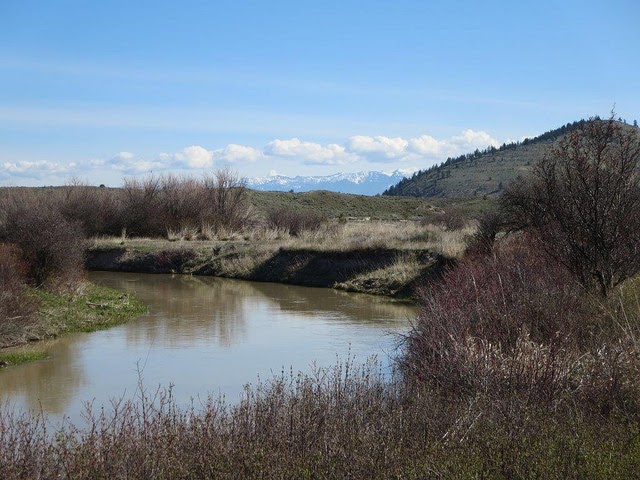
Little Bitterroot River in Montana. Photo credit: USDA
For more than 35 years, the Farm Bill’s Conservation Reserve Program (CRP) has paid farmers and landowners to take highly erodible and other environmentally sensitive lands out of crop production and enroll them instead in conserving practices. Through CRP, the US Department of Agriculture (USDA) pays farmers to set aside land for grass or tree cover for a period of 10 or 15 years. This set aside period helps keep soil in place, prevent water pollution, and create beneficial wildlife and pollinator habitats.
On January 26, USDA announced the following CRP enrollment opportunities:
- The CRP general signup is open from January 31 until March 11, 2022. With 22.5 million acres currently enrolled, Farm Service Agency (FSA) hopes to reach the 25.5 million acre cap set for Fiscal Year (FY) 2022. If your bid is accepted, be prepared to request a conservation plan from Natural Resources Conservation Service (NRCS) by April 15, 2022.
- The Grassland Initiative is open from April 4 until May 13, 2022, and is intended to help farmers with rangeland, pastureland, and similar working lands.
- CRP Continuous signup for automatic, non-competitive enrollment of partial fields and conservation buffers is also open. Hopefully, this time it will remain open continuously through 2023 and beyond.
Last year, FSA enacted a Climate-Smart Practice Incentive for CRP General and Continuous signups, to better target CRP to address climate change. Producers can receive a 3-10% increase in their annual rental payment for utilizing practices that store carbon and reduce greenhouse gas emissions. This incentive still applies to the 2022 signups.
CRP General Signup
Historically, general signups have occurred whenever USDA determined there was sufficient demand and acres available to warrant a general enrollment. Under the terms of the 2018 Farm Bill, however, USDA has been directed to hold a general signup enrollment each year.
The 2022 CRP General signup will open on January 31, 2022, and will close on March 11, 2022
For many conservation-minded farm owners, CRP can provide much-needed financial relief and serve as an environmental lifeline. Many farmers feel pressure to plant on marginal and highly erodible lands in order to maximize the return on their arable land. This is an understandable, short-term financial decision, but it can have long-term detrimental effects on the health of the farm, surrounding environment, and can often actually lower profits per acre.
In order to best serve producers while also safeguarding our shared natural resources and the taxpayers’ investment, USDA must manage CRP in a manner that maximizes environmental benefits. To accomplish this, applicants are ranked using the Environmental Benefits Index (EBI) to help determine how much ecological good each bid creates. The maximum possible score is 545 and each signup includes a minimum required score to qualify for enrollment. The 2021 general signup saw historically low minimum required EBI scores of 175 and 165 in select states. This means that the 2021 signup created far less environmental benefit per acre compared to past signups.
The National Sustainable Agriculture Coalition (NSAC) encourages USDA to keep this in mind as it proceeds with the 2022 general signup. We believe it would be ill-advised to attempt to reach the 25.5 million acres cap for the program with this signup if it interferes with the continuous signup, or if it requires accepting bids with low environmental value and thereby recreates the mistakes of 2021.
The Grasslands Program
CRP’s Grasslands Program is unique in that it is more of a working lands program than a land retirement program. The next signup for the Grasslands Program will begin once general CRP signup ends – tentatively, on April 4th and run through May 13th. The grassland enrollment prioritizes expiring CRP contracts, lands at risk of conversion or development, and grasslands that are important to wildlife and the local ecosystem.
Continuous Signup
Back in the 1990s, NSAC helped to ensure that Congress and USDA recognized the benefits of partial field enrollments of specialized conservation buffer practices (e.g., riparian buffers, filter strips, field windbreaks, contour strips, and grass waterways) on water quality and soil health. Today, farmers and landowners can enroll these buffer practices into CRP without any competitive bidding on a continuous basis. Though now reopened, the continuous signup has been put on hold several times over the last few years due to concerns about available space within the program’s acreage cap. With proper management of CRP by USDA, there is no reason why it should close.
Additional Resources
- USDA’s 2022 Press Release on CRP signup
- USDA has not updated the CRP General Sign Up fact sheet
- USDA has not updated the Grassland CRP Sign Up Fact Sheet
- USDA’s 2021 Continuous CRP Sign Up Fact Sheet
- USDA has not published updated county rental rates for CRP in 2022
- Environmental Benefits Index ranking factors used to determine acceptable bids (changes are coming, but yet unpublished)
Important dates for the CRP General Signup
Source: https://www.fsa.usda.gov/Internet/FSA_Notice/crp_956.pdf?utm_medium=email&utm_source=govdelivery
New Rule on CRP
CRP is still operating under an Interim Final Rule. The rule incorporates changes from the 2018 Farm Bill, including new, lower rental rate payments. General signup enrollments will now be limited to 85 percent of county average rental rates and continuous signup enrollments limited to 90 percent of county average rental rates. Additionally, FSA made edits to the Interim Final Rule in December of last year. The first change eliminates the payment reduction for famers installing edge of field buffers in states where buffers are already required. The second change eliminates the 50% cash match requirement for non-federal CREP partners. NSAC advocated for both changes in public comments and is excited to see them implemented in the program. See FSA’s press release here.

